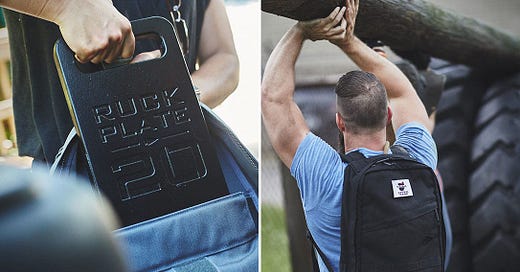Today we’re exploring the heaviest weight you should ruck with.
Consider this the ultimate guide to figuring out how much weight you should ruck with.
What we get wrong about weight
Rucking is beautiful in its simplicity. Load a pack. Sling it on your back and walk. That’s the whole deal. There are only so many ways you can screw it up.
Still, we manage. Using an inappropriate weight is the first and most frequent mistake people make when they start rucking.
But men and women usually have the opposite problem.
Men try to be heroes. We usually go too heavy, too soon. This can result in overuse issues, especially if we ruck frequently.
Women, on the other hand, often go too light. That can lead them to not get as powerful of a workout stimulus as they could.
So there's an inherent tension: We need to go heavy enough to get a serious stimulus, but also not so heavy that we get injured.
Decades of military data show that frequent (very) heavy rucking is a bad idea.
What's "very heavy?"
In The Comfort Crisis, I looked at military research spanning centuries. It suggests we shouldn’t go over 50 pounds. That’s a quick and easy guideline.
But it’s obviously not all that nuanced. For example, rucking with 50 pounds is experienced differently by someone who weighs 110 pounds versus someone who weighs 220 pounds.
That’s why, in 1950, Colonel S.L.A. Marshall did scores of research on rucking. He concluded that a ruck weighing the equivalent of 1/3 of your body weight is the heaviest you should use. Regularly going above 1/3 of your body weight increases your risk of injury. For example, a 180-pound person wouldn’t want to regularly ruck with over 60 pounds. A 110-pound person wouldn’t want to exceed 35ish pounds.
But this adds another complication into the mix. What if you’re overweight or obese? Does that 1/3 bodyweight rule still apply?
Rucking Weight for People With a BMI Over 25
The question of what weight to use if you’re in the “overweight” or “obese” category is critically important.
It impacts a lot of people. Consider that more than 70 percent of Americans are overweight or obese. And rucking is arguably the best exercise tool to help people lose weight. It preferentially burns fat while preserving muscle.
But if you’re overweight or obese, the 1/3rd bodyweight rule could lead you to ruck with far more weight than you should.
It suggests that, for example, a 300-pound person would be fine rucking with 100 pounds. That's way too heavy.
So how do we on one hand account for the fact that the 1/3rd bodyweight guideline is useful in individualizing weight, but also that it might be useless (even dangerous) for a significant number of people?
Here’s the conclusion I came to: The heaviest weight you should regularly use is 1/3rd of your body weight—unless you are overweight or obese.
If you are overweight or obese, see the numbers below.
They're based on BMI. They're equal to 1/3rd of the heaviest body weight that would still put you in the "normal" weight range for your height.
You can think of this as your “heaviest rucking weight for your height." For ease, I grouped heights together and errored on the side of slightly heavier rucking weights (heavier people tend to have more muscle mass). I also rounded up to numbers you can find in gym weights and rucking plates.
5' to 5’2" --> 45 lbs
5'3" to 5'5" --> 50 lbs
5'6" to 5'8" --> 55 lbs
5'9" to 5'11" --> 60 lbs
6' to 6'2" --> 65 lbs
6'3" to 6'5" --> 70 lbs
6'5" to 6'7" --> 75 lbs
Occasionally going over these recommendations won't kill you.
One study on soldiers found that an occasional very heavy ruck probably won’t injure us. But problems arise when we do multiple heavy rucks multiple days in a row.
The stress on the body and lack of recovery push us into the red. (This is why rucking has a higher injury rate in the military than it does among the general population. The military often tasks soldiers with rucking with 100+ pounds for days on end.)
Find your starting weight
That all said, you probably shouldn’t ruck with the heaviest weight you can all the time. I rarely use 1/3 of my bodyweight. When it comes to weight, there’s a rate of diminishing returns—more isn’t always more!
For example, I weigh about 175 pounds and my go-to weight is 35 pounds.
The above weights are a great challenge, but you don't have to push it all the time, especially when you're just starting. It's best to ease in. Look for a load and pace that feels uncomfortable but that you can hold a conversation at.
As a general rule, most active men can start with 20 to 35 pounds. Active women usually do great starting with 10 to 20 pounds. These weights should feel challenging, but not soul-crushing.
If they feel soul-crushing at first, go lighter. For example, let’s say 20 pounds feels too heavy. Try 10 pounds for a few rucks, then bump up to 15 for a few. Soon enough, that 20 pounds will feel better.
From there, feel free to experiment with going heavier. But be aware that rucking somehow breaks the laws of physics. As my friend and founder of Whole30 (which you should try!) Melissa Urban says:
“30 pounds somehow weighs five times more than 20 pounds.” — Melissa Urban, Founder of Whole30
Of course, if your starting weight feels far too easy, add more weight. I’ve had friends who started at 30 and immediately bumped up to 45.
As you become stronger and stronger, you can push the envelope. Just remember to follow the guidelines above. Rucking isn’t meant to be easy. Everyone suffers under the weight of the load. But if you keep rucking, those miles will start to feel easier.




